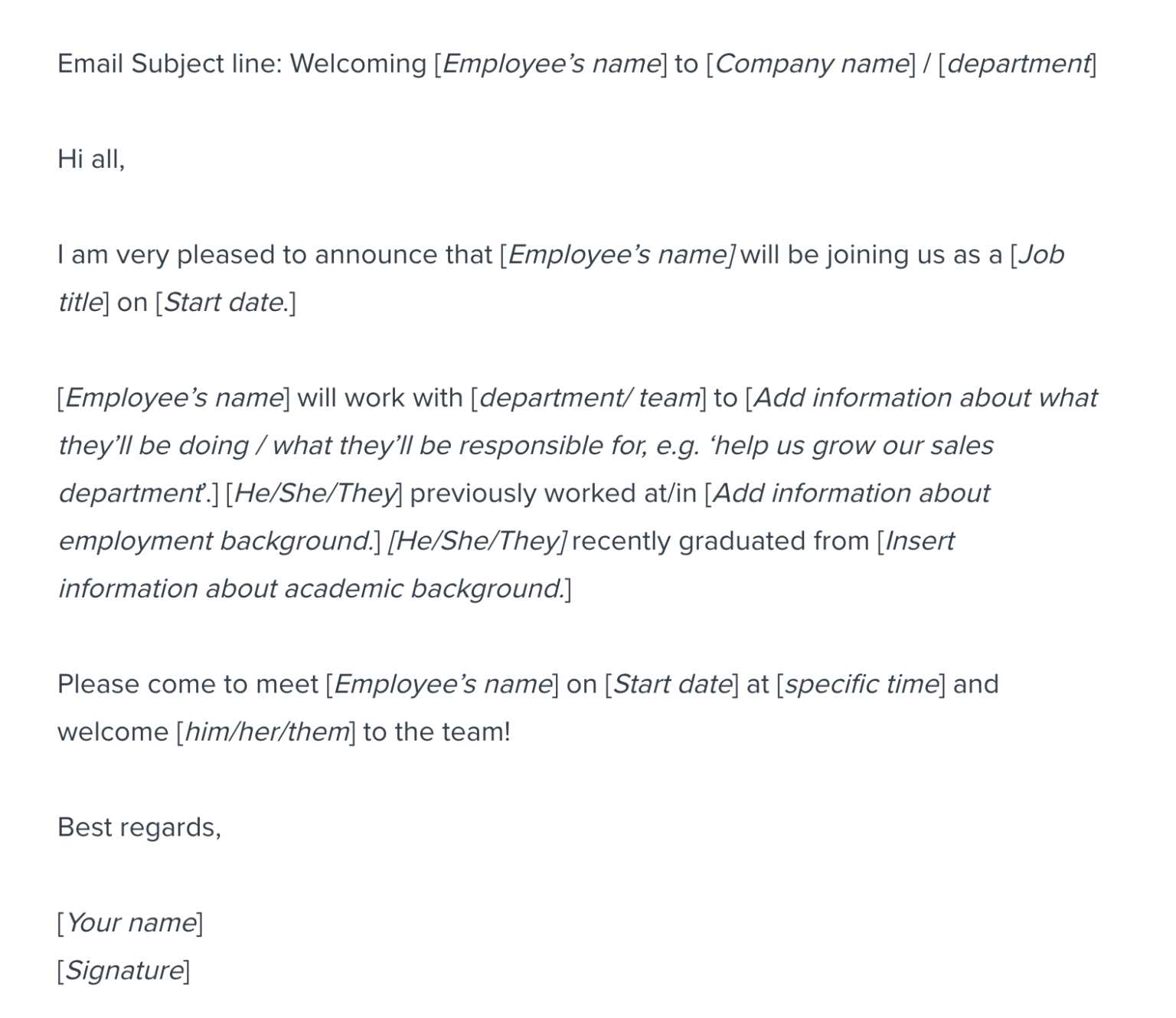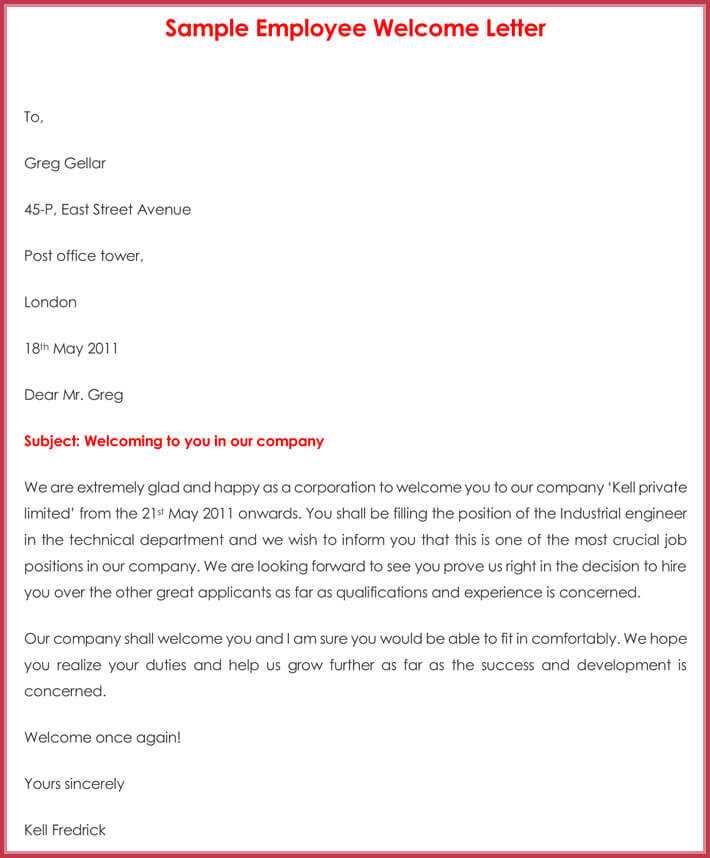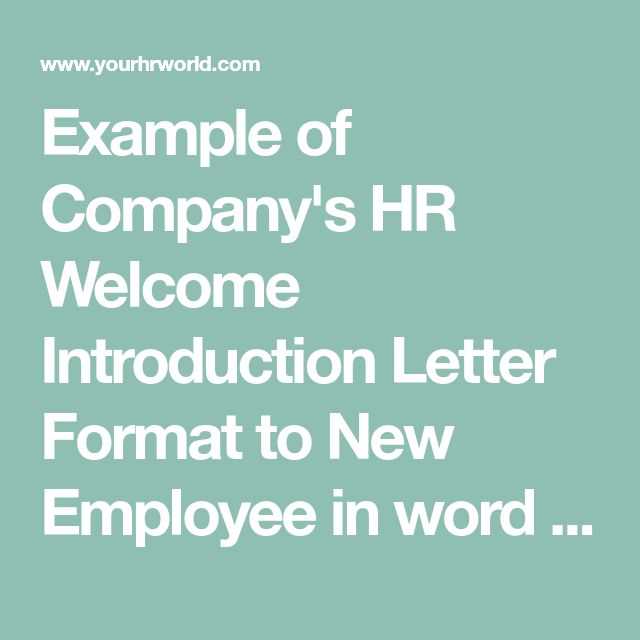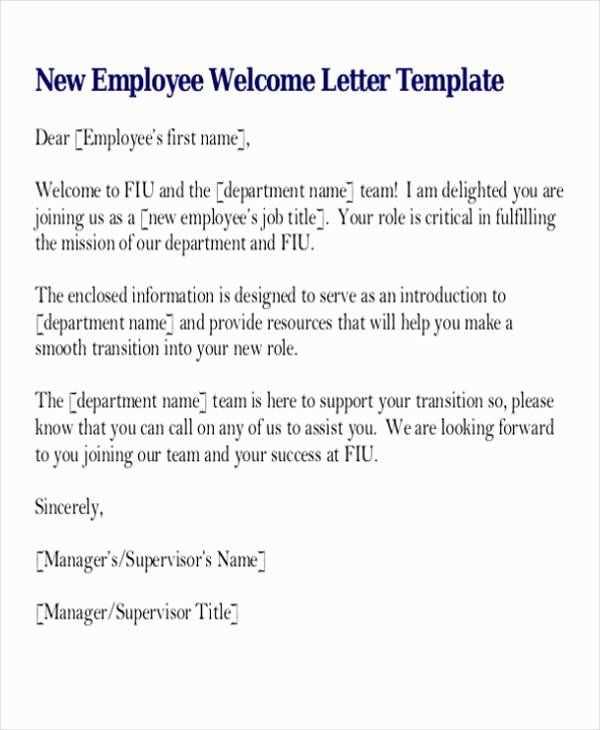Welcome letter template new employee

Start by addressing your new employee directly. Make them feel at ease by highlighting their value and the positive impact they bring to the team. Acknowledge their decision to join your company and show enthusiasm about their future role.
Example: “Dear [Employee’s Name],
We are thrilled to have you as part of our team. Your skills and experience will make a significant contribution to our success, and we are excited to see the impact you’ll have with us. We believe you’ll quickly feel at home and enjoy working alongside our talented group of professionals.
Provide clear, relevant details about the next steps. Share any essential information regarding their first day, workspace, and team introductions. This helps ease their transition into the role and sets expectations from the start.
Example: “On your first day, please report to [Office Location] at [Start Time]. You’ll be introduced to your team, given a tour of the office, and set up with everything you need. We’ll make sure you have all the tools to succeed from day one.”
Wrap up with an open invitation for questions or concerns, reinforcing your support and availability. Encourage them to reach out as they settle in, so they feel comfortable and informed.
Example: “Should you have any questions before or after your start date, don’t hesitate to contact me directly. We’re here to help and ensure your experience is as smooth as possible.”
Sign off with a welcoming and warm note, reinforcing excitement for the new partnership.
Example: “Once again, welcome to the team. We’re looking forward to working with you and achieving great things together!”
Here’s the revised version:
Personalize the welcome letter with the new employee’s name and role to make them feel immediately included. Begin with a clear statement of excitement about their arrival and the value they bring to the team. Keep the tone warm but professional, expressing confidence in their contributions.
Ensure the letter includes key details such as the start date, team structure, and any initial tasks or projects they will be involved in. This will provide a clear understanding of what to expect in the first days. Offer contact information for key team members or departments they might need to reach out to for support.
Encourage the new hire to ask questions and assure them that the company is committed to their success. Conclude with a positive, welcoming message, reinforcing that you’re excited to see their impact on the team and organization.
- Welcome Letter Template for New Employees
Begin with a warm and direct greeting that makes the new employee feel valued. Start by introducing yourself and expressing excitement about them joining the team. Keep it friendly but professional.
For example:
Dear [Employee’s Name],
Welcome to [Company Name]! We’re thrilled to have you with us and are excited for the contributions you’ll bring to our team. We’re confident that you’ll find our workplace both supportive and dynamic as you settle in.
Next, provide important details about their first days. Let them know who to reach out to for assistance and give a brief overview of what they can expect in the coming weeks. This helps reduce uncertainty.
Example:
During your first few days, you’ll have the chance to meet key team members and familiarize yourself with our processes. Please don’t hesitate to reach out to [Supervisor/HR Name] for any questions you may have as you adjust to your new role.
End the letter with another warm message of support and encouragement, reinforcing that the team is there to help them succeed.
Example:
We’re looking forward to seeing you thrive here at [Company Name]. Should you need anything, feel free to ask. We’re all here to help each other succeed.
Sincerely,
[Your Name]
[Your Position]
A welcome letter sets the tone for a new employee’s experience with your company. It provides clarity about the organization’s values and culture right from the start. By sending this letter before their first day, you show commitment to making them feel part of the team from the very beginning.
Clear communication in the welcome letter builds confidence. When a new hire knows exactly what to expect on their first day–whether it’s the dress code, parking instructions, or whom to report to–they are better prepared. It also reflects the company’s professionalism and attention to detail.
The letter acts as an opportunity to reinforce the company’s mission and vision. A thoughtful message emphasizes that the employee’s role is valued, boosting morale and motivation. It creates a connection between the employee’s individual goals and the company’s broader mission, enhancing long-term engagement.
A personalized welcome letter makes the new hire feel noticed and appreciated. Instead of a generic greeting, mention specifics about their role or team. A personalized message goes a long way in making someone feel that they belong, which can positively affect retention rates.
Begin with a warm welcome. Acknowledge the employee’s role and excitement about them joining the team. Express enthusiasm about the unique skills they bring to the company.
Clear Role and Expectations
Clearly state the employee’s position and primary responsibilities. Outline what is expected of them in the first few months, providing a sense of direction right from the start. This helps them understand their contribution and sets a productive tone.
Team Introduction
Introduce key team members and departments they’ll interact with. Offering a brief overview of coworkers, managers, or departments gives the new hire a clearer picture of the team dynamic.
End with an invitation for open communication. Encourage the employee to ask questions or seek guidance as they settle in. This promotes a welcoming and accessible company culture.
Tailor each message to highlight the individual’s role and background. Mention their unique skills and the specific projects they’ll be involved in. This helps create an immediate connection and shows your attention to detail.
- Use their full name and job title in the greeting to make it personal.
- Reference their past experiences or achievements that are relevant to their new role.
- Include a brief mention of the team or department they will be joining, emphasizing how they will contribute to the overall success.
Including small personal touches, like referencing a shared interest or a mutual connection, makes the message feel more thoughtful. For example, “I’m excited to see how your passion for marketing will bring new ideas to the table here.”
- Customize the tone based on their role. For example, a more formal tone might be fitting for senior positions, while a friendly and casual approach works well for entry-level positions.
- Make sure to mention specific tools, technologies, or methodologies they’ll be using, which can show that you’ve done your homework.
Conclude by expressing enthusiasm about working together and inviting them to reach out if they need any assistance during their transition. A few words about your company culture or values can also provide a warm welcome.
Use a warm and welcoming tone that encourages engagement. Keep the language clear, concise, and free of jargon to ensure ease of understanding. Your goal is to make the new employee feel at ease and excited about their role from the very start.
1. Use Simple, Direct Language

Avoid complex phrases or unnecessary embellishments. Focus on the key points that will help the employee transition smoothly. Clear, direct communication builds trust and reduces potential confusion.
2. Be Personal but Professional

- Address the employee by name to create a personal connection.
- Balance friendliness with professionalism–avoid overly casual expressions, but ensure warmth is conveyed.
- Use positive, encouraging words to promote a sense of belonging and excitement.
3. Maintain a Positive and Supportive Tone

Highlight the opportunities ahead and reassure them about the support available. Focus on creating an atmosphere of enthusiasm and collaboration, where the employee feels confident in reaching out and contributing.
4. Avoid Overloading with Information
- Give just enough detail to answer immediate questions and spark curiosity.
- Provide additional resources in follow-up emails or during onboarding sessions for deeper insights.
The best time to send the welcome letter is right after the employee has confirmed their start date, ideally within 24 to 48 hours. Sending it too early may cause confusion, while a delay can leave the new hire feeling uncertain about their first day.
Before the First Day
Send the letter at least a few days before the employee’s first day. This allows them time to prepare and feel welcomed, but not too much time in advance to become irrelevant or forgotten. The letter should arrive as part of their onboarding materials, including other important details like their schedule, office protocols, and team introductions.
Key Timing Factors
Consider your organization’s culture and the role. If it’s a remote job, the letter can be emailed as soon as the start date is confirmed. For on-site roles, it’s helpful to send the letter before any pre-employment meetings or orientations. The goal is to ensure the employee feels prepared and valued before stepping through the door or logging in for the first time.
Personalize the welcome letter by including specific details about the employee’s role, department, and start date. For example, instead of using a generic greeting, say: “Dear [Employee Name], welcome to the [Department Name] team as our new [Job Title]. We’re excited to have you on board starting [Start Date].”
To make the letter more engaging, mention any immediate tasks or goals the employee can expect. For instance: “On your first day, you’ll meet with [Supervisor Name] for an orientation session and get familiar with your workspace. Your first project will be [Task Description], and we look forward to your contributions.”
Here’s a simple template you can customize:
- Subject: Welcome to [Company Name]!
- Dear [Employee Name],
- We’re excited to have you join us as [Job Title] in the [Department Name]. Your start date is [Start Date], and we’re looking forward to seeing you thrive in your new role.
- On your first day, you’ll meet with [Supervisor Name] for a quick orientation. Feel free to ask any questions during this time!
- If you need anything before then, don’t hesitate to contact [Contact Name] at [Contact Email].
- We look forward to a successful future together!
- Best regards, [Your Name] and the [Department Name] team
This format allows you to quickly plug in the necessary information and customize the tone. You can adjust the level of formality based on your company culture while making sure the letter remains welcoming and informative.
Provide clear and specific information for new employees by incorporating key details in the welcome letter. Highlight the company’s values and mission succinctly, and offer helpful resources to make their onboarding experience smoother.
| Item | Description |
|---|---|
| Welcome Message | A short, friendly greeting expressing excitement about the new hire joining the team. |
| Team Introduction | Provide the new employee with a brief overview of the team they will be working with, including names and roles. |
| Work Environment | Include important details about the office layout or remote work guidelines, highlighting any specific procedures they should follow. |
| Resources | Direct the new hire to resources like the employee handbook, training modules, and the IT support team for any technical assistance. |
Keep the tone positive and welcoming, while keeping information easily accessible. Avoid overwhelming the new hire with too much detail initially.